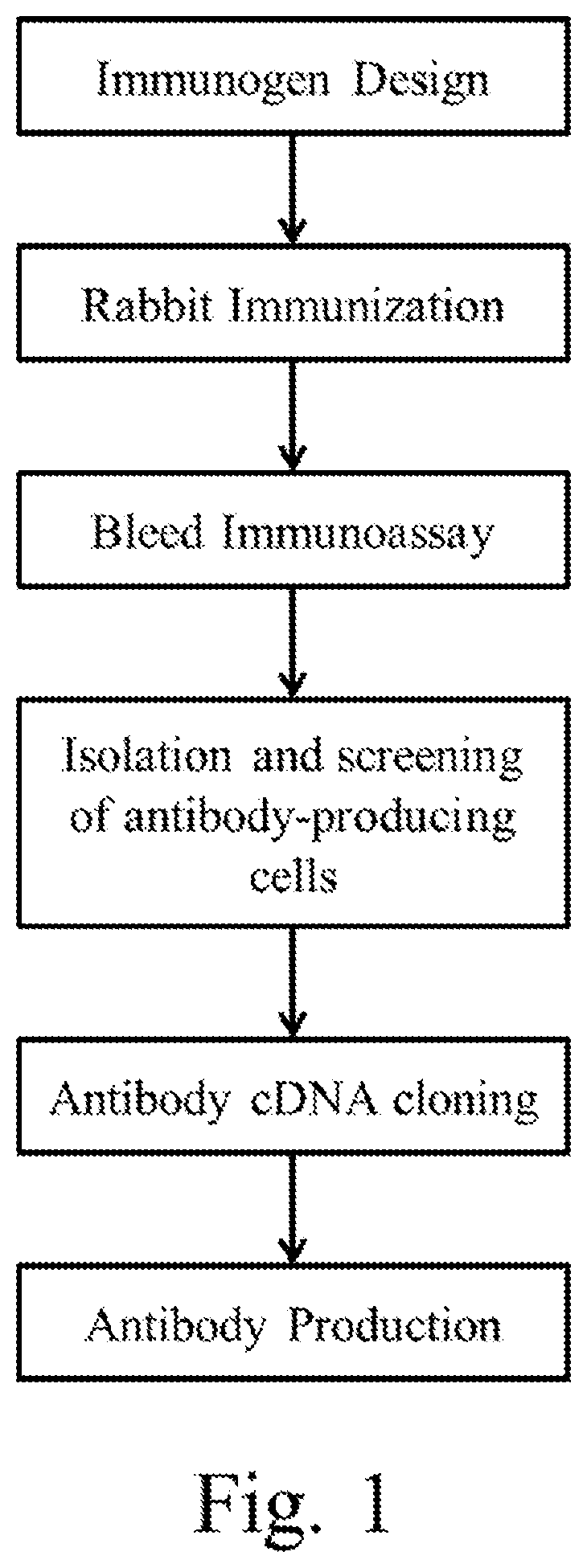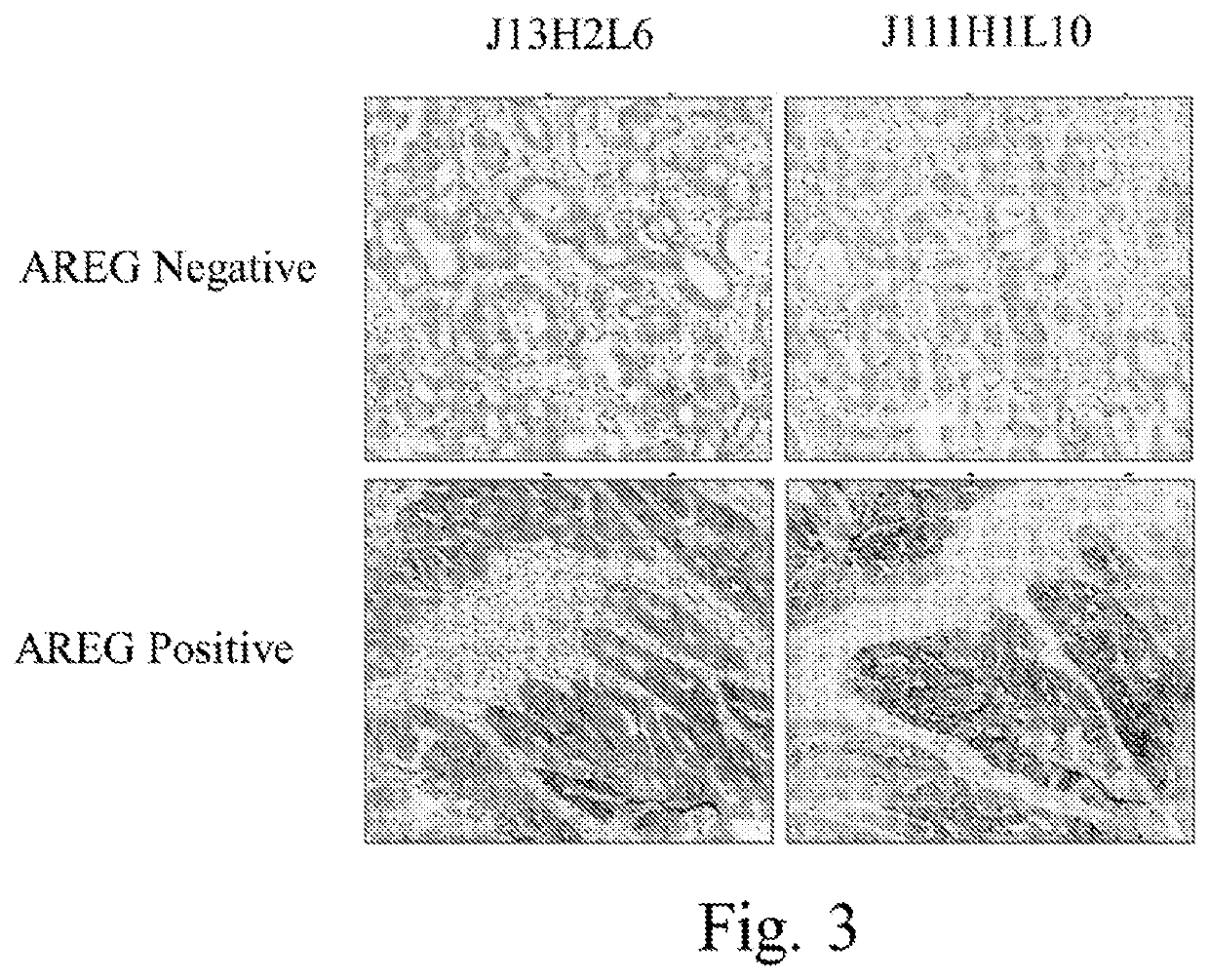Materials and methods for performing histochemical assays for human pro-epiregulin and amphiregulin
- Summary
- Abstract
- Description
- Claims
- Application Information
AI Technical Summary
Benefits of technology
Problems solved by technology
Method used
Image
Examples
example 1
Generation of Anti-Human Pro-Epiregulin Antibodies Against Amino Acids 148-169 of SEQ ID NO: 1
[0272]Anti-human pro-epiregulin rabbit monoclonal antibodies were generated as schematically depicted in FIG. 1.
[0273]Briefly, the peptide fragment of amino acid residues 148-169 of SEQ ID NO: I was synthesized and conjugated via glutaraldehyde to keyhole limpet hemocyanin (KLH), an extensively used carrier protein for stimulating a substantial immune response via antibody production. New Zealand. White rabbits were immunized with KLH conjugated human pro-epiregulin antigen emulsified with complete Freund's adjuvant followed by a series of human pro-epiregulin antigen booster emulsified with incomplete Freund's adjuvant. The antibody-expressing cells were screened by enzyme-linked immunoabsorbant assay (ELISA) using the human pro-epiregulin antigen. All ELISA positive clones were further screened by immunohistochemistry (IHC), and the clone producing the antibody with the highest specificit...
example 2
Generation of Anti-Human Amphiregulin Antibodies
[0276]Anti-human amphiregulin rabbit monoclonal antibodies were generated as schematically depicted in FIG. 1. Briefly, the peptide fragment of amino acid residues 238-252 of SEQ ID NO: 36 was synthesized and conjugated via glutaraldehyde to keyhole limpet hemocyanin (KLH), an extensively used carrier protein for stimulating a substantial immune response via antibody production. New Zealand White rabbits were immunized with KLH conjugated human amphiregulin antigen emulsified with complete Freund's adjuvant followed by a series of human amphiregulin antigen booster emulsified with incomplete Freund's adjuvant. The antibody-expressing cells were screened by enzyme-linked immunoabsorbant assay (ELISA) using the human amphiregulin antigen. All ELISA positive clones were further screened by immunohistochemistry (IHC), and the clone producing the antibody with the highest specificity was selected. For recombinant production of anti-human am...
example 3
Immunohistochemical Assays Using Anti-Human Pro-Epiregulin and Anti-Human Amphiregulin Antibodies
Reagents
[0279]All assay optimization were performed on human non-small cell lung carcinoma (NSCLC) (NCI-H1975; NCI-H1650; H460; NCI-HCC827; H2228; Calu-3; H820), breast (MCF7; A431) carcinoma cell lines and colorectal cancer tissues. Stained slides for the tested conditions were evaluated by a trained pathologist and the optimal staining conditions were determined based on the staining intensity, percentage of positive cells and the level of non-specific (background) staining. The examined and the nominal conditions (bold) developed for EREG / AREG IHC is shown in Table 3.
TABLE 3The examined and the nominal assay conditions (bold) for EREG / AREG IHC assaysProcedureXT OptiView DAB IHCAntibodyEREGEREGEREGEREGEREGAREGAREGD4O5IS17H9L6J59H1L2J23H3.12L7J5H1L1J13H2L6J111H1L10Sample TypeCarcinoma cell lines; Colorectal cancer casesParaffinSelectedDe-SelectedparaffinizationCellCC1: 32CC1: 0-32-CC1: ...
PUM
| Property | Measurement | Unit |
|---|---|---|
| Fraction | aaaaa | aaaaa |
| Temperature | aaaaa | aaaaa |
| Fraction | aaaaa | aaaaa |
Abstract
Description
Claims
Application Information
 Login to View More
Login to View More - R&D
- Intellectual Property
- Life Sciences
- Materials
- Tech Scout
- Unparalleled Data Quality
- Higher Quality Content
- 60% Fewer Hallucinations
Browse by: Latest US Patents, China's latest patents, Technical Efficacy Thesaurus, Application Domain, Technology Topic, Popular Technical Reports.
© 2025 PatSnap. All rights reserved.Legal|Privacy policy|Modern Slavery Act Transparency Statement|Sitemap|About US| Contact US: help@patsnap.com



